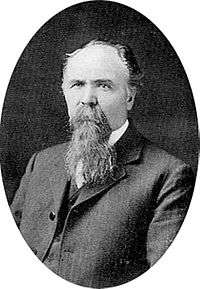Franklin Hiram King
| Franklin Hiram King | |
|---|---|
|
Franklin Hiram King, from the frontispiece of Farmers of Forty Centuries (1911). | |
| Born |
8 June 1848 Whitewater, Wisconsin, United States |
| Died |
4 August 1911 (aged 63) United States |
| Nationality | American |
| Fields | agricultural scientist |
| Institutions | University of Wisconsin–Madison |
| Known for | storage silo |
Franklin Hiram King (8 June 1848 – 4 August 1911) was an American agricultural scientist who was born on a farm near Whitewater, Wisconsin, attended country schools, and received his professional training first at Whitewater State Normal School and then at Cornell University.
King served as a professor of agricultural physics at the University of Wisconsin–Madison from 1888 until 1902. Interested in a wide range of subjects throughout his career, King made major contributions during these years in research and teaching that dealt with applications of physics to agriculture. Most attention was given to soil physics, for example, water-holding capacities of soils, moisture requirements of plants, aeration, movement of water in soils, movement of groundwater, the drafts of plows, and the lifting power of windmills; he also began studies of soil fertility. The impact of his career was greatest in the field of soil science. He has been called the father of soil physics in the United States.
King left Wisconsin to become chief of the Division of Soil Management in the USDA Bureau of Soils in Washington, D.C. in January 1902. His findings in the next two years, that the concentration of nutrients in soil solution was correlated with crop yields, began to undermine beliefs held strongly by the chief of the bureau about the relations of soil chemistry to plant growth and soil fertility. King was forced to resign but privately published several additional papers from his research during this period.
King returned to Madison, where he devoted the last seven years of his life to summarizing earlier findings and conducting further research in agricultural physics, including the ventilation of farm buildings. Three of his seven books were written during that period, the best known of which is Farmers of Forty Centuries, or Permanent Agriculture in China, Korea, and Japan, which recounted his investigations into what would now be called organic farming or sustainable agriculture during a nine-month tour of Asia in 1909. The last chapter was completed after his death by his wife, Carrie Baker King. The book was published in 1911 and was described by Lord Northbourne – the founder of organic agriculture – as a "classic" which "no student of farming or social science can afford to ignore".[1]
He is most popularly known for designing the cylindrical storage silo, which reduces the occurrence of moldy corners in the grain. Some have speculated that Frank Lloyd Wright's design of the Guggenheim Museum was influenced by King's designs. King is commemorated at the University of Wisconsin–Madison by King Hall, so renamed in 1934, which is the same Agricultural Physics Hall in which he worked during his tenure there and which now houses part of the Department of Soil Science (formed by the 1904 reorganization of King's original department into the 'Soils Department' and the 'Agricultural Engineering Department'), and by the F.H. King Students for Sustainable Agriculture, a student organization that grows various crops that are given away to community residents to raise awareness of sustainable farming and gardening.
Partial bibliography of books by F. H. King
- The Soil (1895)
- Irrigation and Drainage (1899)
- Ventilation for Dwellings, Rural Schools, and Stables (1908)
- Farmers of Forty Centuries, or Permanent Agriculture in China, Korea and Japan (1911)
References
- ↑ Northbourne, L., 1940, Look to the land, J. M. Dent, London, p. 17, p. 55, apud Paull, John, "Permanent Agriculture: Precursor to Organic Farming", Elementals: Journal of Bio-Dynamics Tasmania, no.83, pp. 19–21, 2006.
External links
- Works by Franklin Hiram King at Project Gutenberg
- Works by or about Franklin Hiram King at Internet Archive
- Tanner, C.B. and Simonson, R.W. "Franklin Hiram King – Pioneer Scientist", Soil Science Society of America Journal: Volume 57, no. 1, January–February 1993. (Reprinted at U. of Wisconsin)
- Franklin Hiram King (1895). The Soil, Its Nature, Relations, and Fundamental Principles of Management. Macmillan & co., ltd.
- Taylor, Mrs. H. J. "Franklin Hiram King", The Wilson Bulletin, June 1933
- F.H. King documents from East Asia at Univ of Wisconsin–Madison
- King Hall, Univ of Wisconsin–Madison
- F.H. King Students for Sustainable Agriculture group at Univ of Wisconsin–Madison
